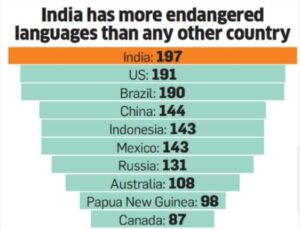“One language can unite people. Two languages are sure to divide people. This is an inexorable law. Culture is conserved by Language.”- Dr. Bhim Rao Ambedkar
Language is the only weapon to express individuality and culture and is one of the ultimate insignias of human diversity. Approximately 7000 existing dialects in the realm are there and about 3000 are under extinction threat. In other words, nearly half of the dialectal variety in the world is under threat. India is no exception in this case as a sharp alarm is ringing. Around 197 languages are losing their existence in India. “India may have lost 220 languages since 1961.”- reported by Ganesh N Devy, founder-director of Bhasa Research. Undoubtedly, most of the languages are still not recognized by the Indian government, and Hindi and Bengali are enlisted in the most used languages in India.
Sanctioned Languages under Indian Constitution
However, in the constitution, the eighth schedule includes 22 considerable languages- Malayalam, Bengali, Manipuri, Kannada, Kashmiri, Assamese, Konkani, Hindi, Marathi, Nepali, and so on. But still, several linguistic diversities are endangered which is the major concern. Every state wants to preserve its native or local languages. Even in the case of education, the states and the locals want to enlist their languages as the first medium of education in schools.
The concern

Figure: Showing the number of languages that are at risk
(Source: Seetharaman, 2017)
It is indeed a thoughtful and concerning topic for the states who are pondering over the recognition of the languages in the Indian constitution. While extinction threat reveals threat over some languages, a number of other languages have been thriving. For instance, Gondi, an indigenous language of Odisha, Bhili of Maharastra, Rajasthan, and Gujarat, and Garo and Khasi of Meghalaya are indicating a tremendous growth as literate citizens in these states are already flaunting their languages using them for writing as well as speaking. Therefore, people of such places are fighting and trying to preserve their indigenous languages. Since the grant of Tamil, Sanskrit, Kannada, Telugu, Malayalam, and Odia in the Classical status in India, thirty-eight states are motivating themselves and requesting for including their languages for literacy and demanding for the inclusion of languages in the Indian Constitution. Undoubtedly, the 22 languages have got the preference of the Indian government on some grounds. One of the major grounds was that more than 10000 people speak and write the languages.
Is Multi-Lingual Education beneficial?
Indeed, mother tongue-based multi-lingual education can show a pivotal role in safeguarding indigenous languages. No one can deny that avoiding mother tongue-based intervention in early childhood, can hinder the learning process of the children. Reportedly, Mother tongue-based multi-lingual education allows the tribal inhabitants to operate in different languages equally.

Figure: Indian languages under the constitution
A way better!!!
It is significant to incorporate tribal knowledge schemes just besides modern studies in the syllabus of institutions. Indigenous languages are vital to identify the world where we dwell and the origin. Thus there is an urgent need to encourage the indigenous languages as the primary medium of education as well as communication in selective districts in order to preserve their existence. Simultaneously, it is high time to cherish the role of the indigenous languages in elevating cultural and linguistic diversity.
References
Dwidedi, K. (2017, August 4). 10% Of World’s Endangered Languages Spoken In India: Report. Retrieved from Outlook: https://www.outlookindia.com/newswire/story/10-of-worlds-endangered-languages-spoken-in-india-report/972864
Seetharaman, G. (2017, August 13). Seven decades after Independence, many small languages in India face extinction threats. Retrieved from The Economic Times: https://economictimes.indiatimes.com/news/politics-and-nation/seven-decades-after-independence-many-small-languages-in-india-facing-extinction-threat/articleshow/60038323.cms